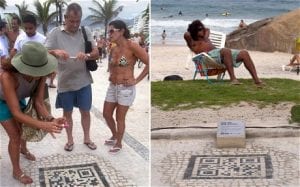At last – digital and social are finally becoming accessible in a place that we can all appreciate it to the full – the street! As digital advancements move offline, not only are we seeing the technology divide slip away, but we can experience digital in a more physical (and natural) way. This post discusses three stories of socially interactive street-based digital campaigns that will expand the boundaries of what digital can do.
Social scientists for years have used the ‘street’ as a way of observing, analysing and reporting on social interactions. Although we may refer to the street as a metaphor – Facebook could be classed as a ‘street’ for fans and Small Business Can a ‘street’ for small business owners; the physical street shows engagement in it’s truest and most natural form.
Story 1: Socially interactive QR Codes on the Pavement
QR Codes are scrambled images that can be scanned by smartphones to direct you to a digital location (web page, social media page, map, event page). For the rapidly growing smartphone population, QR Codes are ideal marketing tools for increasing goal conversions in real time. Due to popularity and availability of wireless internet, QR usage has proved an instant success.
BUT, what if you could take QR Codes to the next level. What if, instead of printing them on flyers or business cards and waiting for wannabee customers/clients to come to you, you created your QR codes in the most public, socially-interactive zone on the planet? I’m talking about a place that the whole world has in the common; the street.
Well in Rio De Janeiro that’s exactly what they did with this socially interactive street-based digital campaign. In a bid to ‘pave’ the way for the 2016 Olympics, the travel sector has again come up trumps. All across Rio you’ll see QR Codes on the pavements. If you scan them, you’ll be presented with tourist information on historical monuments and maps of the area.
Story 2: Burberry and the Offline Digital Store
Whilst it isn’t exactly the street, a retail store is not dissimilar in that it works as a highly engaging social zone. The act of shopping fulfils a social need in a feel-good setting. Popularity again makes it an ideal spot for a digital-social interaction.
Burberry’s flagship London store has been modelled on the website, so that the customer experience mirrors the online one. That’s clothes embedded with chips which activate when you look in the mirror, so that you can view the item on the catwalk and see how it was made. There are checkouts that come to you and in-store iPads.
This kind of digital-social upgrade has transported Burberry into a digital-savvy retailer that understands the power of social in the real world. It works as a benchmark for all other retailers to follow and it will be interesting to see who accepts the challenge to join them.
Burberry also upped the outdoor social ante with QR Codes on clothes tags during Catwalk shows and live streamed events.
Story 3: TNT Benelux Sells Public Drama with a Socially Interactive Red Button
This story starts in a quiet Belgium square, where those seeking drama could click a red button with the arrowed remark ‘Push to add drama’. And boy if you’re brave enough, do you get a reward!
TNT Benelux set up this social promotion to share TV drama by creating a kind of ‘flash mob’ style event. When the red button was pressed, a dramatic scene was played out in front of the public’s eyes.
This socially interactive street-based digital campaign cleverly represents the dramatic tone of the TV channel and despite it being location-based, the ‘viral’ video of the enactment became one of the most viewed globally.
[youtube width=”645″ height=”344″]http://www.youtube.com/watch?v=316AzLYfAzw[/youtube]
These are just a few street-based digital examples and I know there are countless more, but do you know of any unbelievable ones you can share?
Did you like this article? Write for the site. Sign up for our RSS.
Image: Source: http://www.thedrum.com/news/2013/01/28/rio-de-janeiro-puts-qr-codes-pavements





